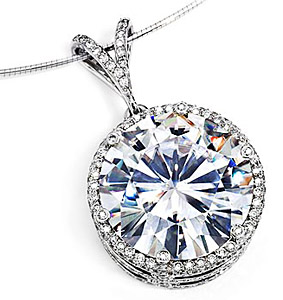The history of natural Moissanite can be traced back to the late 1800`s, and a man who later became a Nobel Prize winner. Dr. Henri Moissan discovered natural silicon carbide in Arizona, while analyzing part of the Diablo Canyon meteorite, in 1893. The name Moissanite was given in Dr. Moissan`s honor in 1905. The synthetic Moissanite is known as silicon carbide because of its chemistry and the trade name is carborundum.
 Moissanite is considered sturdier than diamond because it has no natural fractures that can crack if the stone is subjected to an impact of some kind. Also, Moissanite, at 9.25 Mohs, is second in hardness only to diamond and incredibly tough. This is the reason that Moissanite maintains its clarity and sparkle throughout a lifetime. It will not look like a piece of rock salt, like cubic zirconia, after two weeks.
Moissanite is considered sturdier than diamond because it has no natural fractures that can crack if the stone is subjected to an impact of some kind. Also, Moissanite, at 9.25 Mohs, is second in hardness only to diamond and incredibly tough. This is the reason that Moissanite maintains its clarity and sparkle throughout a lifetime. It will not look like a piece of rock salt, like cubic zirconia, after two weeks.
Regarding colour Moissanite cannot compare in color to a colorless diamond. Moissanite has a slightly darker but really cannot be differentiated from a diamond in the same setting. Moissanite`s essence was the potential for an absolutely shimmering brilliance, fire, luster, and incredible hardness. For all these qualities it can compete to all other gemstones. This gemstone possesses all the romance and passion of rubies, emeralds and sapphires. Moissanite is found only in meteorites and in limited areas beneath the earth`s surface.
Unlike other diamond, it is thermally conductive and this property is used as the test for the authenticity of real diamonds. Other things, which differentiate Moissanite with diamond, are that it is hexagonal and doubly refractive. It is also less dense and rarely has the clarity of color. A pale shade of green is always there.
Naturally occurring moissanite is extremely rare and found only in microscopic crystals that are too small to use in jewelry. Only after years of research a breakthrough discovery enabled the production of moissanite crystals large enough to produce an uncommon combination of science and art. Natural sources of silicon carbide are rare, and only certain atomic arrangements are useful for gemological applications. Recently, single-crystalline silicon carbide, in certain forms, has been used for the fabrication of high-performance semiconductor devices. North Carolina-based Cree Research, Inc., founded in 1987, has developed a commercial process for producing large single crystals of silicon carbide. Cree is the world leader in the growth of single crystal silicon carbide, mostly for electronics use. Gem quality Moissanite is created, exclusively by Charles & Colvard, Inc.
The specific gravity of moissante stone is from 3.1 to 3.2 and hardness 9.25 on Mohs scale.
 Moissanite is considered sturdier than diamond because it has no natural fractures that can crack if the stone is subjected to an impact of some kind. Also, Moissanite, at 9.25 Mohs, is second in hardness only to diamond and incredibly tough. This is the reason that Moissanite maintains its clarity and sparkle throughout a lifetime. It will not look like a piece of rock salt, like cubic zirconia, after two weeks.
Moissanite is considered sturdier than diamond because it has no natural fractures that can crack if the stone is subjected to an impact of some kind. Also, Moissanite, at 9.25 Mohs, is second in hardness only to diamond and incredibly tough. This is the reason that Moissanite maintains its clarity and sparkle throughout a lifetime. It will not look like a piece of rock salt, like cubic zirconia, after two weeks.Regarding colour Moissanite cannot compare in color to a colorless diamond. Moissanite has a slightly darker but really cannot be differentiated from a diamond in the same setting. Moissanite`s essence was the potential for an absolutely shimmering brilliance, fire, luster, and incredible hardness. For all these qualities it can compete to all other gemstones. This gemstone possesses all the romance and passion of rubies, emeralds and sapphires. Moissanite is found only in meteorites and in limited areas beneath the earth`s surface.
Unlike other diamond, it is thermally conductive and this property is used as the test for the authenticity of real diamonds. Other things, which differentiate Moissanite with diamond, are that it is hexagonal and doubly refractive. It is also less dense and rarely has the clarity of color. A pale shade of green is always there.
Naturally occurring moissanite is extremely rare and found only in microscopic crystals that are too small to use in jewelry. Only after years of research a breakthrough discovery enabled the production of moissanite crystals large enough to produce an uncommon combination of science and art. Natural sources of silicon carbide are rare, and only certain atomic arrangements are useful for gemological applications. Recently, single-crystalline silicon carbide, in certain forms, has been used for the fabrication of high-performance semiconductor devices. North Carolina-based Cree Research, Inc., founded in 1987, has developed a commercial process for producing large single crystals of silicon carbide. Cree is the world leader in the growth of single crystal silicon carbide, mostly for electronics use. Gem quality Moissanite is created, exclusively by Charles & Colvard, Inc.
The specific gravity of moissante stone is from 3.1 to 3.2 and hardness 9.25 on Mohs scale.